When methane was mentioned at the end of Section 4.2 "Covalent Compounds: Formulas and Names", we described it as the simplest organic compound. In this section, we introduce organic chemistry more formally.
Organic chemistryThe study of the chemistry of carbon compounds. is the study of the chemistry of carbon compounds. Carbon is singled out because it has a chemical diversity unrivaled by any other chemical element. Its diversity is based on the following:
Curiously, elemental carbon is not particularly abundant. It does not even appear in the list of the most common elements in Earth’s crust. (See Table 2.1 "Elemental Composition of Earth" in Chapter 2 "Elements, Atoms, and the Periodic Table".) Nevertheless, all living things consist of organic compounds.
Most organic chemicals are covalent compounds, which is why we introduce organic chemistry here. By convention, compounds containing carbonate ions and bicarbonate ions, as well as carbon dioxide and carbon monoxide, are not considered part of organic chemistry, even though they contain carbon.
The simplest organic compounds are the hydrocarbonsThe simplest organic compound, composed of carbon and hydrogen atoms only., compounds composed of carbon and hydrogen atoms only. Some hydrocarbons have only single bonds and appear as a chain (which can be a straight chain or can have branches) of carbon atoms also bonded to hydrogen atoms. These hydrocarbons are called alkanes (saturated hydrocarbons)A hydrocarbon with only single covalent bonds and existing as a chain of carbon atoms also bonded to hydrogen atoms.. Each alkane has a characteristic, systematic name depending on the number of carbon atoms in the molecule. These names consist of a stem that indicates the number of carbon atoms in the chain plus the ending -ane. The stem meth- means one carbon atom, so methane is an alkane with one carbon atom. Similarly, the stem eth- means two carbon atoms; ethane is an alkane with two carbon atoms. Continuing, the stem prop- means three carbon atoms, so propane is an alkane with three carbon atoms. Figure 4.6 "Formulas and Molecular Models of the Three Simplest Alkanes" gives the formulas and the molecular models of the three simplest alkanes. (For more information about alkanes, see Chapter 12 "Organic Chemistry: Alkanes and Halogenated Hydrocarbons".)
Figure 4.6 Formulas and Molecular Models of the Three Simplest Alkanes
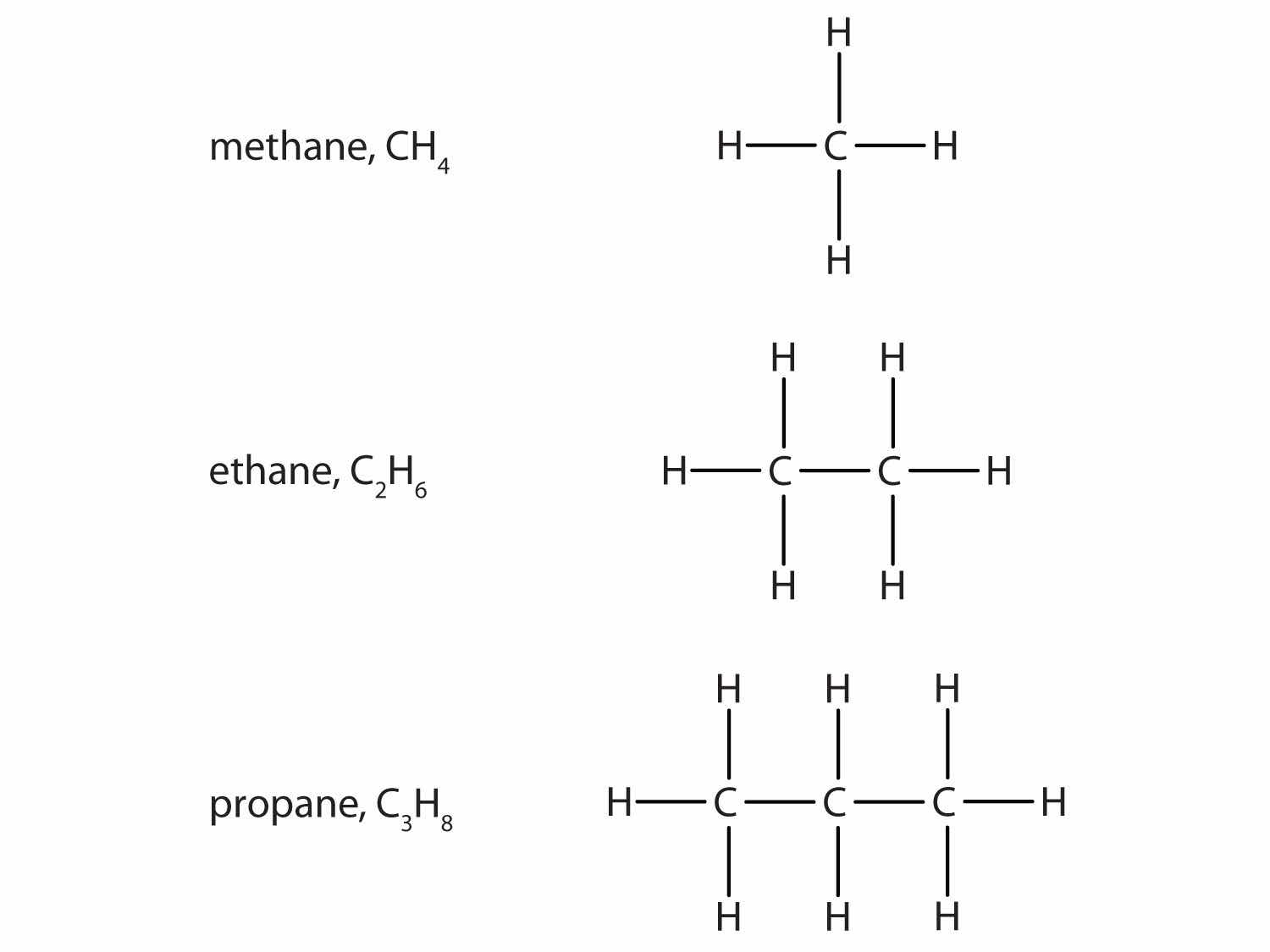
The three smallest alkanes are methane, ethane, and propane.
Some hydrocarbons have one or more carbon–carbon double bonds (denoted C=C). These hydrocarbons are called alkenesA hydrocarbon with one or more carbon–carbon double bonds.. Figure 4.7 "Formulas and Molecular Models of the Two Simplest Alkenes" shows the formulas and the molecular models of the two simplest alkenes. Note that the names of alkenes have the same stem as the alkane with the same number of carbon atoms in its chain but have the ending -ene. Thus, ethene is an alkene with two carbon atoms per molecule, and propene is a compound with three carbon atoms and one double bond.
Figure 4.7 Formulas and Molecular Models of the Two Simplest Alkenes

Ethene is commonly called ethylene, while propene is commonly called propylene.
AlkynesA hydrocarbon with a carbon–carbon triple bond. are hydrocarbons with a carbon–carbon triple bond (denoted C≡C) as part of their carbon skeleton. Figure 4.8 "Formulas and Molecular Models of the Two Simplest Alkynes" shows the formulas and the molecular models of the two simplest alkynes and their systematic names. The names for alkynes have the same stems as for alkanes but with the ending -yne. (For more information about alkenes and alkynes, see Chapter 13 "Unsaturated and Aromatic Hydrocarbons".)
Figure 4.8 Formulas and Molecular Models of the Two Simplest Alkynes
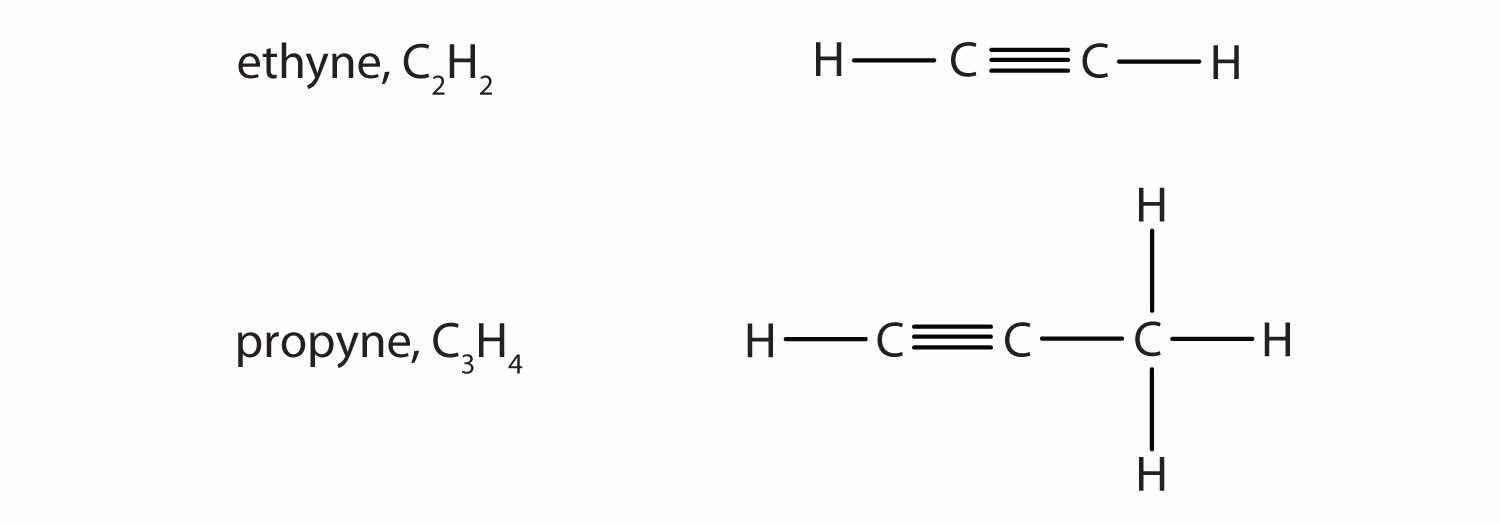
Ethyne is more commonly called acetylene.
The compound acetylene, with its carbon–carbon triple bond, was introduced in Section 4.3 "Multiple Covalent Bonds" and is an alkyne.
Hydrocarbons are not the only compounds that can have carbon–carbon double bonds. A group of compounds called fats can have them as well, and their presence or absence in the human diet is becoming increasingly correlated with health issues.
Fats are combinations of long-chain organic compounds (fatty acids) and glycerol (C3H8O3). (For more information on fats, see Chapter 17 "Lipids", Section 17.1 "Fatty Acids".) The long carbon chains can have either all single bonds, in which case the fat is classified as saturated, or one or more double bonds, in which case it is a monounsaturated or a polyunsaturated fat, respectively. Saturated fats are typically solids at room temperature; beef fat (tallow) is one example. Mono- or polyunsaturated fats are likely to be liquids at room temperature and are often called oils. Olive oil, flaxseed oil, and many fish oils are mono- or polyunsaturated fats.
Studies have linked higher amounts of saturated fats in people’s diets with a greater likelihood of developing heart disease, high cholesterol, and other diet-related diseases. In contrast, increases in unsaturated fats (either mono- or polyunsaturated) have been linked to a lower incidence of certain diseases. Thus, there have been an increasing number of recommendations by government bodies and health associations to decrease the proportion of saturated fat and increase the proportion of unsaturated fat in the diet. Most of these organizations also recommend decreasing the total amount of fat in the diet.
Recently, certain fats called trans fats have been implicated in the presence of heart disease. These are fats from animal sources and are also produced when liquid oils are exposed to partial hydrogenation, an industrial process that increases their saturation. Trans fats are used in many prepared and fried foods. Because they bring with them the health risks that naturally occurring saturated fats do, there has been some effort to better quantify the presence of trans fats in food products. US law now requires that food labels list the amount of trans fat in each serving.
Since 1992, the US Department of Agriculture has been promoting a food pyramid that gives a simple, visual picture of how much of what kind of foods make up a good, balanced diet. It recommends eating as few fats as possible. Although nutritionists recognize that some fat is necessary (and largely unavoidable, even by strict vegetarians), they emphasize that a large proportion of any fat, saturated or unsaturated, in the diet is unhealthy. Even so, a difference as simple as the difference between a single and double carbon–carbon bond can have a significant impact on health.
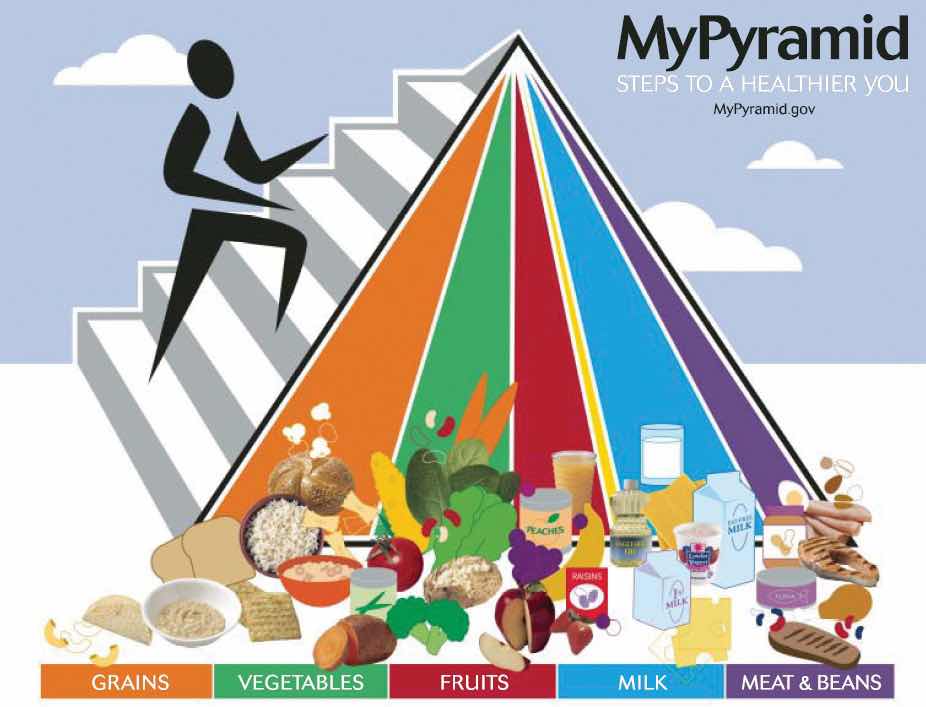
The food pyramid has suggestions for the number of daily servings of each type of food.
Source: Image courtesy of the USDA, http://www.mypyramid.gov/downloads/MiniPoster.pdf.
The carbon–carbon double and triple bonds are examples of functional groupsA specific structural arrangement of atoms or bonds that imparts a characteristic chemical reactivity to a molecule. in organic chemistry. A functional group is a specific structural arrangement of atoms or bonds that imparts a characteristic chemical reactivity to a molecule. Alkanes have no functional group. A carbon–carbon double bond is considered a functional group because carbon–carbon double bonds chemically react in specific ways that differ from reactions of alkanes (for example, under certain circumstances, alkenes react with water); a carbon–carbon triple bond also undergoes certain specific chemical reactions. In the remainder of this section, we introduce two other common functional groups.
If an OH group (also called a hydroxyl group) is substituted for a hydrogen atom in a hydrocarbon molecule, the compound is an alcoholAn organic compound with an OH functional group.. Alcohols are named using the parent hydrocarbon name but with the final -e dropped and the suffix -ol attached. The two simplest alcohols are methanol and ethanol. Figure 4.9 "The Two Simplest Organic Alcohol Compounds" shows their formulas along with a molecular model of each.
Figure 4.9 The Two Simplest Organic Alcohol Compounds
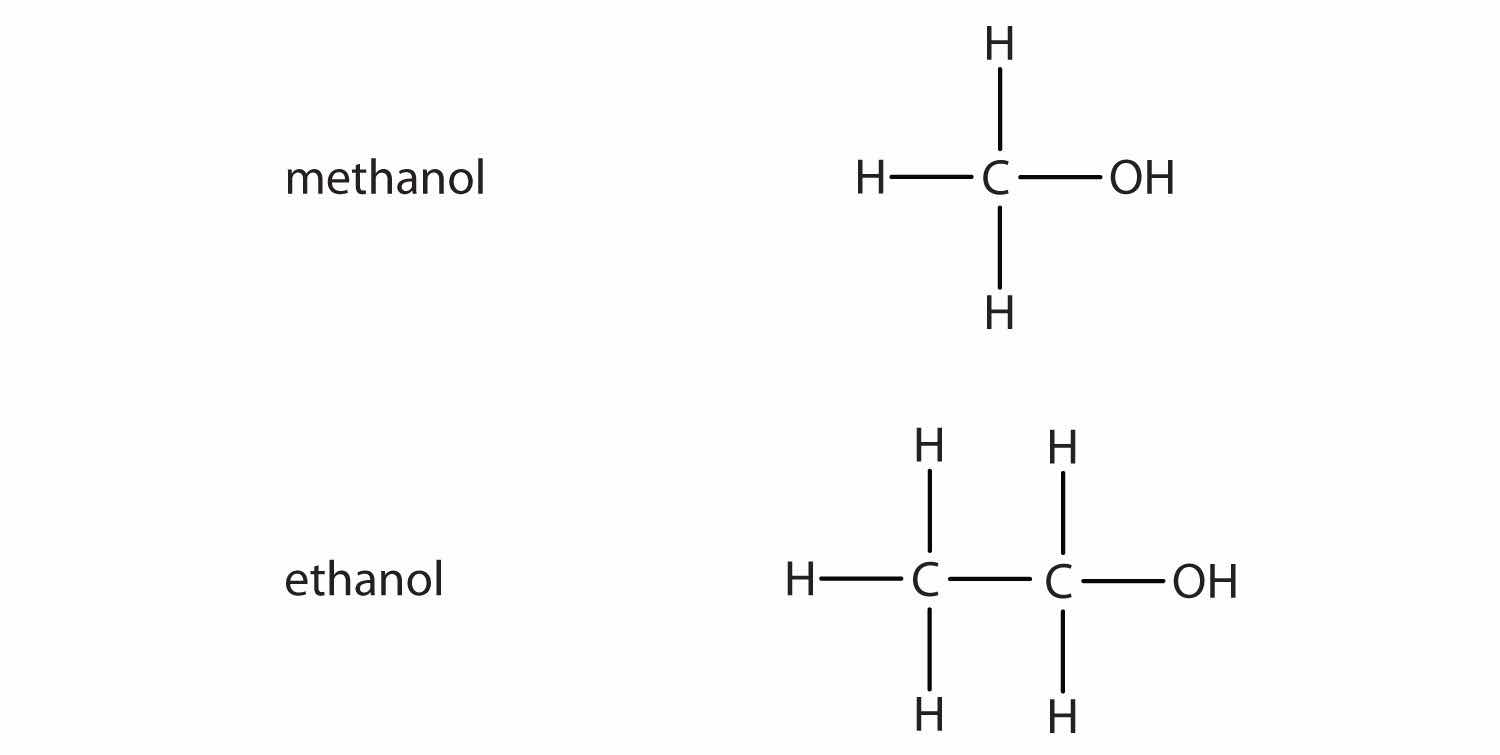
Alcohols have an OH functional group in the molecule.
Cholesterol, described in the chapter-opening essay, has an alcohol functional group, as its name implies.
Ethanol (also called ethyl alcohol) is the alcohol in alcoholic beverages. Other alcohols include methanol (or methyl alcohol), which is used as a solvent and a cleaner, and isopropyl alcohol (or rubbing alcohol), which is used as a medicinal disinfectant. Neither methanol nor isopropyl alcohol should be ingested, as they are toxic even in small quantities.
Another important family of organic compounds has a carboxyl groupA functional group that contains a carbon–oxygen double bond and an OH group also attached to the same carbon atom., in which a carbon atom is double-bonded to an oxygen atom and to an OH group. Compounds with a carboxyl functional group are called carboxylic acidsAn organic compound that has a carboxyl functional group., and their names end in -oic acid. Figure 4.10 "The Two Smallest Organic Acids" shows the formulas and the molecular models of the two simplest carboxylic acids, perhaps best known by the common names formic acid and acetic acid. The carboxyl group is sometimes written in molecules as COOH.
Figure 4.10 The Two Smallest Organic Acids
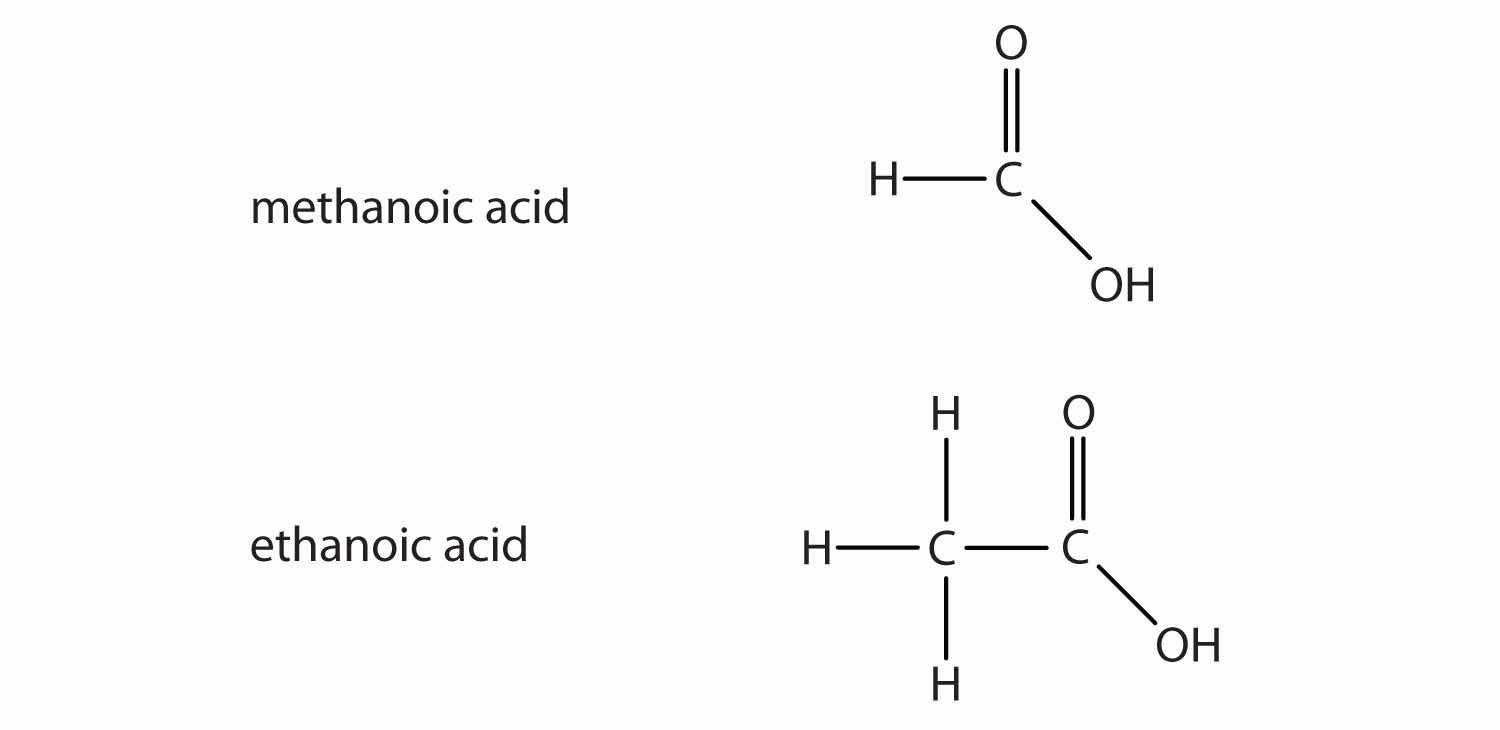
The two smallest carboxylic acids are formic acid (found in the stingers of ants) and acetic acid (found in vinegar).
Many organic compounds are considerably more complex than the examples described here. Many compounds, such as cholesterol discussed in the chapter-opening essay, contain more than one functional group. The formal names can also be quite complex. In Chapter 12 "Organic Chemistry: Alkanes and Halogenated Hydrocarbons" through Chapter 15 "Organic Acids and Bases and Some of Their Derivatives", we will examine the characteristics and chemistry of other important organic compounds and functional groups.
Identify the functional group(s) in each molecule as a double bond, a triple bond, an alcohol, or a carboxyl.



Solution
Identify the functional group(s) in each molecule as a double bond, a triple bond, an alcohol, or a carboxyl.




The main job of a forensic chemist is to identify unknown materials and their origins. Although forensic chemists are most closely associated in the public mind with crime labs, they are employed in pursuits as diverse as tracing evolutionary patterns in living organisms, identifying environmental contaminants, and determining the origin of manufactured chemicals.
In a crime lab, the forensic chemist has the job of identifying the evidence so that a crime can be solved. The unknown samples may consist of almost anything—for example, paint chips, blood, glass, cloth fibers, drugs, or human remains. The forensic chemist subjects them to a variety of chemical and instrumental tests to discover what the samples are. Sometimes these samples are extremely small, but sophisticated forensic labs have state-of-the-art equipment capable of identifying the smallest amount of unknown sample.
Another aspect of a forensic chemist’s job is testifying in court. Judges and juries need to be informed about the results of forensic analyses, and it is the forensic chemist’s job to explain those results. Good public-speaking skills, along with a broad background in chemistry, are necessary to be a successful forensic chemist.
What is organic chemistry?
What is a functional group? Give at least two examples of functional groups.
Organic chemistry is the study of the chemistry of carbon compounds.
A functional group is a specific structural arrangement of atoms or bonds that imparts a characteristic chemical reactivity to the molecule; alcohol group and carboxylic group (answers will vary).
Give three reasons why carbon is the central element in organic chemistry.
Are organic compounds based more on ionic bonding or covalent bonding? Explain.
Identify the type of hydrocarbon in each structure.




Identify the type of hydrocarbon in each structure.




Identify the functional group(s) in each molecule.




Identify the functional group(s) in each molecule.




How many functional groups described in this section contain carbon and hydrogen atoms only? Name them.
What is the difference in the ways the two oxygen atoms in the carboxyl group are bonded to the carbon atom?
Carbon atoms bond reasonably strongly with other carbon atoms. Carbon atoms bond reasonably strongly with atoms of other elements. Carbon atoms make a large number of covalent bonds (four).
two; carbon-carbon double bonds and carbon-carbon triple bonds